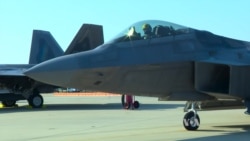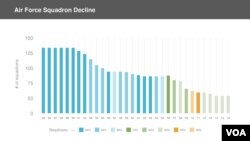When Iraqi troops began the operation to retake Mosul last month, fighter pilots in America’s F-22 Raptor jets struck the first Islamic State targets there. But that kind of operation may be in jeopardy.
The U.S. Air Force says a shortage of fighter pilots has become so dire that it is struggling to satisfy combat requirements abroad.
“We have too few squadrons to meet the combatant commanders’ needs,” Major General Scott Vander Hamm, the general in charge of fixing the fighter pilot crisis, said in an exclusive interview with VOA.
The Air Force is currently authorized to have 3,500 fighter pilots, but it is 725 fighter pilots short. And with fewer pilots, the number of fighter pilot squadrons have also dropped, from 134 squadrons in 1986 to 55 in 2016.
As a greater percentage of the force has needed to be deployed over the past 10 years, readiness -- the ability to accomplish missions at home and abroad -- has dropped 20 percent.
Some 'unpalatable options'
“We’re having to look across the board and offer some pretty unpalatable options as we get after it,” Vander Hamm told VOA, “and we may have to, within the next calendar year, start to take some degradations in the frontline squadrons."
“What that would mean to us is that we would have to accept not being able to get forces to theater in the same time we could, which to a warfighter, that means it could cost lives in a conflict,” he said.
Each pilot needs years of training to maneuver high-tech aircraft, which have evolved into flying supercomputers.
The Air Force is now training about 135 more pilots than two years ago, but that effort appears to have been undercut by the number of fighter pilots who have chosen to leave the Air Force.
After about 10 years, pilots are offered a bonus payment as incentive to stay on in the force. But in fiscal 2016, only 40 percent took the bonus. Vander Hamm told VOA the Air Force needs to retain about two-thirds of its fighter pilots up for contract renewal in order to fill the slots needed in the force.
Deployments
At Joint Base Langley-Eustis, pilots who fly the F-22 Raptor say that longer and more frequent deployments have devastated morale.
“We were on 45-day rotations. Then they made it 90-day rotations. Then they made it 120-day rotations. Now it’s six-month rotations with one-year rotations sprinkled on top of it for key positions,” said a lieutenant colonel who asked only to be identified by his call sign “Buz” due to his commander’s concern about potential retaliation from enemy terror groups.
The deployments aren’t the only thing causing pilots to quit. While stationed at home, pilots often have to work extra hours to finish administrative tasks, in addition to maintaining their flying skills.
“All of the same responsibilities fall on about half the number of people who were there before, and that creates a pretty high demand on these guys and their work life,” Colonel Pete Fesler, the commander of the 1st Fighter Wing at Joint Base Langley-Eustis, told VOA.
The fighter pilot shortage has spiked at a time when commercial airlines, which offer more stable schedules at home and the potential for higher pay, are looking for more pilots.
“If it’s up to just me, I definitely would stay in, but my family has a vote,” a major who asked to be identified by his call sign “Jack” told VOA. “If they want me to leave to do something else, then that’s probably what I’ll end up doing.”
Solution to crisis
Tom Hunt, a former fighter pilot who left the Air Force in 2013, says he decided to leave for several reasons. He says he now earns more money as a Washington, D.C., lawyer.
He says the solution to the crisis does not have to be complex. “Some people say you can’t throw money at everything, you can. You absolutely can. If you said, the pilot bonus is now $500,000, single-lump sum payment, (I) guarantee you will solve your pilot shortage,” Hunt said.
However, he also noted that paying one group so much more than another group might cause tension within the force, no matter how much the pay increase might be deserved.
The Air Force is asking Congress for money to raise the bonus from $25,000 per year to $48,000 per year, the first such bonus increase since 1999. They also have pledged to decrease administrative duties for fighter pilots in the squadrons.
The Pentagon hopes it will be enough to retain experienced pilots needed to keep up the Air Force’s fast-paced operations as well as train new recruits.












